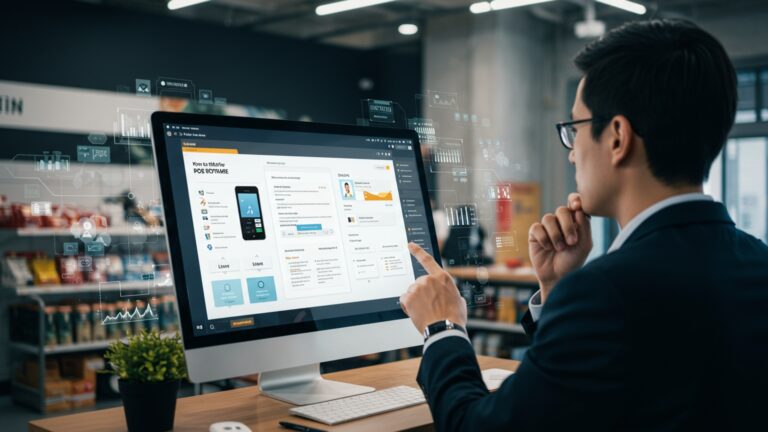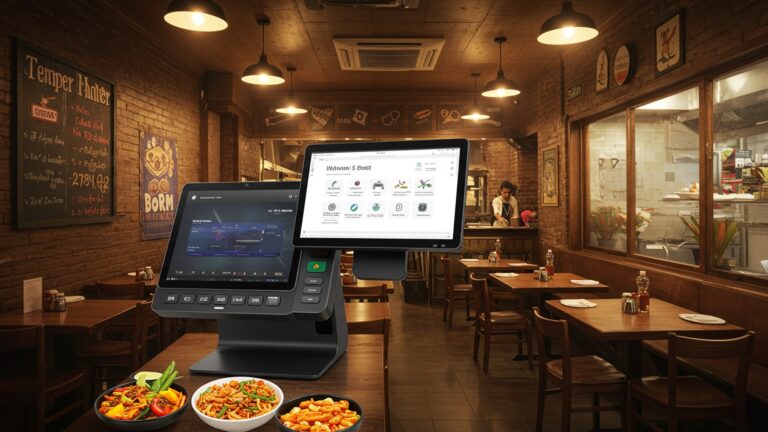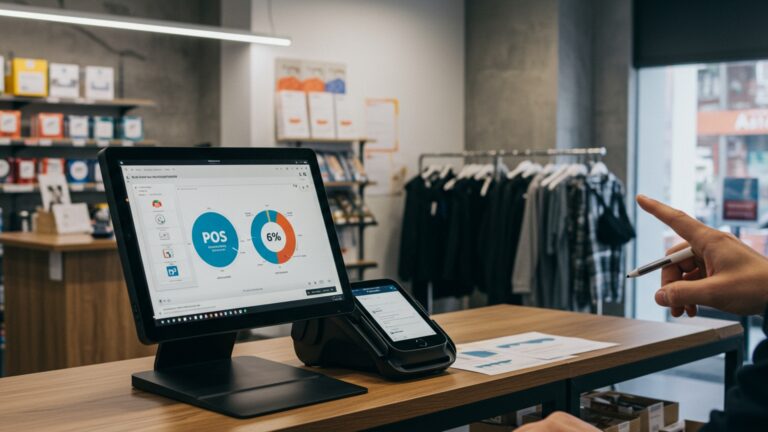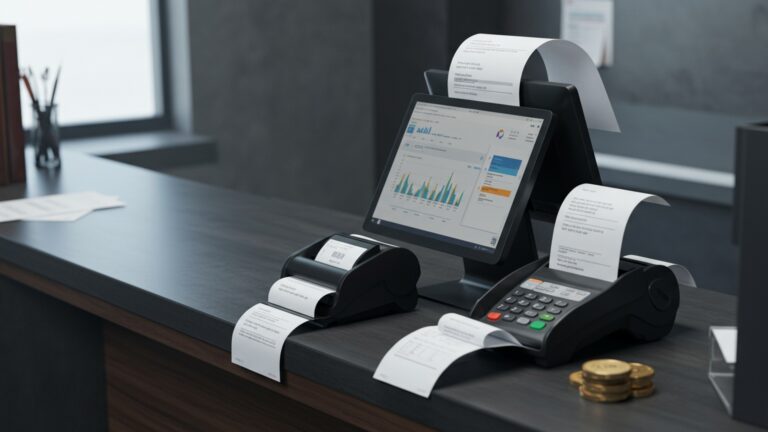How to Choose the Best Restaurant POS Software for Your Business
Navigating the bustling, tech-driven restaurant industry means your Point of Sale (POS) system is no longer just a cash register; it’s the central nervous system powering every interaction, from kitchen display systems to customer loyalty programs. The market now brims with advanced restaurant POS software, featuring cloud-based architecture, integrated online ordering. AI-driven analytics that transform raw data into actionable insights. Forward-thinking restaurateurs prioritize solutions offering real-time inventory management, robust employee scheduling. seamless integration with third-party delivery platforms. Making the right choice is critical, as a strategic POS empowers operational efficiency, enhances guest experiences with features like QR-code ordering. ultimately drives profitability in an increasingly competitive and digitally-reliant environment.

Understanding Restaurant POS Software: More Than Just a Cash Register
In today’s fast-paced culinary world, a robust Point of Sale (POS) system is the backbone of any successful restaurant operation. Far beyond simply processing payments, modern restaurant POS software acts as a central nervous system, managing everything from order taking and kitchen communication to inventory, staffing. customer relationship management. For many years, a POS system was often viewed as merely a digital cash register. But, that perception is outdated. Today, it’s an integrated platform designed to optimize efficiency, reduce costs. enhance the overall dining experience.
At its core, restaurant POS software records transactions. its true power lies in the data it collects and the processes it streamlines. Imagine a busy Friday night: orders flow seamlessly from the front-of-house to the kitchen, inventory updates in real-time as dishes are prepared. staff clock in and out with ease. This level of operational harmony is precisely what a well-chosen POS system delivers. It provides invaluable insights into sales trends, peak hours, popular menu items. even server performance, empowering restaurateurs to make data-driven decisions.
Core Features of Essential Restaurant POS Software
When evaluating restaurant POS software, certain features are non-negotiable. These are the foundational elements that every restaurant, regardless of size or concept, needs to operate efficiently.
- Order Management
- Payment Processing
- Inventory Management
- Reporting and Analytics
- Customer Relationship Management (CRM)
- Employee Management
This is the heart of any restaurant POS. It includes intuitive interfaces for taking orders (table service, takeout, delivery), modifying items, splitting checks. sending orders directly to the kitchen display system (KDS) or printers. The ability to customize orders, add special requests. manage modifiers (e. g. , “no onions,” “extra cheese”) is crucial.
Secure and versatile payment processing is fundamental. Your chosen restaurant POS software must support various payment methods, including credit/debit cards (EMV chip cards), mobile payments (Apple Pay, Google Pay), gift cards. even contactless options. PCI compliance is paramount to protect sensitive customer data and prevent fraud.
Keeping track of ingredients and supplies is vital for cost control and preventing waste. Basic inventory features should allow you to track stock levels, receive new inventory, set reorder points. identify popular or underperforming items. Advanced systems can even deduct ingredients from inventory as dishes are sold.
Data is king. Essential reporting includes daily sales summaries, shift reports, product mix reports. payment method breakdowns. These reports help you grasp your business’s performance, identify trends. make informed decisions about staffing, menu engineering. marketing.
While not always a deep dive, basic CRM features can include capturing customer contact data, tracking order history. managing loyalty programs. This helps personalize the dining experience and encourages repeat business.
This feature handles employee clock-in/out, shift scheduling, tip reporting. permissions management. It ensures accurate payroll processing and allows you to control access to sensitive system functions based on roles.
Advanced Features: Elevating Your Restaurant Operations
Beyond the basics, many restaurant POS software solutions offer advanced features that can significantly enhance efficiency, customer experience. profitability. Consider these “nice-to-haves” that can become “must-haves” as your business grows.
- Kitchen Display Systems (KDS)
- Online Ordering & Delivery Integration
- Table Management
- Advanced Inventory & Recipe Management
- Multi-Location Management
- Gift Card & Loyalty Programs
A digital KDS replaces paper tickets, streamlining communication between front-of-house and kitchen staff. It allows chefs to view orders, mark items as prepared. track cooking times, reducing errors and improving order flow, especially during peak hours.
In today’s market, online ordering is essential. Look for restaurant POS software that integrates seamlessly with your website for direct online orders or with popular third-party delivery platforms (e. g. , DoorDash, Uber Eats). This reduces manual entry and potential errors.
For full-service restaurants, this feature helps manage table assignments, waitlists, reservations. table status (e. g. , seated, ordered, paid). It optimizes seating efficiency and improves guest experience.
More sophisticated systems can break down dishes into individual ingredients, allowing for precise food costing, waste tracking. even suggesting purchase orders based on sales forecasts. This is crucial for managing food costs, which typically represent a significant portion of a restaurant’s expenses.
If you operate multiple restaurants, your restaurant POS software should offer centralized management for menus, inventory, pricing. reporting across all locations. This provides a holistic view of your entire enterprise.
Robust integrated loyalty programs can incentivize repeat visits, while branded gift card programs serve as an excellent revenue stream and marketing tool.
Cloud-Based vs. On-Premise POS Systems: A Critical Comparison
One of the most fundamental decisions you’ll make when choosing restaurant POS software is whether to opt for a cloud-based (SaaS – Software as a Service) or an on-premise system. Each has distinct advantages and disadvantages.
| Feature | Cloud-Based POS | On-Premise POS |
|---|---|---|
| Data Storage | Data stored remotely on vendor’s servers (internet connection required). | Data stored locally on your restaurant’s servers. |
| Upfront Cost | Typically lower; subscription-based model. | Higher; requires purchasing hardware and software licenses. |
| Ongoing Costs | Monthly/annual subscription fees, often includes support and updates. | Maintenance, IT support, manual updates, potential hardware upgrades. |
| Accessibility | Access from any internet-enabled device (e. g. , tablet, smartphone, laptop). | Primarily accessible from within the restaurant network. |
| Updates & Maintenance | Vendor handles updates and maintenance automatically. | Requires manual updates by IT staff or third-party service; you are responsible for maintenance. |
| Scalability | Highly scalable; easy to add or remove terminals/features. | Can be more complex and costly to scale. |
| Security | Managed by vendor with enterprise-grade security, often more robust. | Your responsibility; security depends on your internal IT practices. |
| Offline Capability | Many offer “offline mode” for basic transactions during internet outages, syncing when connectivity returns. | Functions fully without internet. remote access is limited. |
For most modern restaurants, especially those seeking flexibility, lower upfront costs. remote management capabilities, cloud-based restaurant POS software is often the preferred choice. It allows you to monitor sales and manage operations even when you’re not physically on-site, a significant advantage for busy owners.
Integration Capabilities: A Seamless Ecosystem
A truly effective restaurant POS software doesn’t exist in a vacuum. Its ability to integrate with other essential business tools can dramatically enhance efficiency and data accuracy. Look for systems that offer robust Application Programming Interfaces (APIs) or pre-built integrations with third-party solutions.
- Accounting Software
- Online Ordering & Delivery Platforms
- Payroll Services
- Reservation Systems
- Loyalty & Marketing Platforms
Seamless integration with platforms like QuickBooks, Xero, or Sage eliminates manual data entry, reducing accounting errors and saving valuable time. Sales data, payroll data. inventory costs can flow directly into your accounting ledger.
As mentioned, direct integration is key. This means orders placed through your website or services like Uber Eats automatically appear in your POS, preventing double entry and missed orders.
Integration with payroll providers simplifies employee management by automatically transferring clock-in/out times and tip details, streamlining the payroll process.
For fine dining or busy establishments, linking your POS with a reservation system (e. g. , OpenTable, Resy) can provide a comprehensive view of guest arrivals, seating. ordering preferences.
Integrating with dedicated loyalty programs or email marketing tools allows for automated customer engagement, targeted promotions. personalized offers based on purchasing history.
When a POS system integrates well, it creates a unified operational ecosystem, reducing manual effort, minimizing errors. providing a holistic view of your business performance.
Hardware Considerations for Your Restaurant POS Software
While the software is the brain, the hardware is the body. The right hardware ensures your restaurant POS software runs smoothly and efficiently. Consider the following components:
- POS Terminals
- Payment Processors/Card Readers
- Receipt Printers
- Kitchen Display Systems (KDS)
- Cash Drawers
- Barcode Scanners
- Network Infrastructure
These can range from traditional touchscreen monitors to tablets (iPads, Android tablets). Tablets offer mobility, allowing servers to take orders tableside, which can speed up service and improve accuracy.
Ensure compatibility with EMV chip cards, contactless payments (NFC). magstripe. Consider wireless options for tableside payments.
Thermal printers are common for quiet, fast printing. You may need multiple printers for different stations (e. g. , kitchen, bar, front counter).
Digital screens in the kitchen displaying orders, often touch-enabled for marking items complete.
Secure storage for cash payments.
Useful for quick inventory management, especially for retail components of your restaurant (e. g. , bottled beverages, merchandise).
Reliable Wi-Fi and wired Ethernet connections are critical, especially for cloud-based systems. Consider backup internet options.
When selecting hardware, assess its durability, ease of use. compatibility with your chosen restaurant POS software. Many POS vendors offer bundled hardware packages, which can simplify the setup process.
Evaluating Vendors and Support
Choosing the right restaurant POS software is as much about the vendor as it is about the technology. A reliable vendor provides excellent support, continuous updates. a partnership approach.
- Customer Support
- Training
- Reputation & Reviews
- Updates & Future Development
- Contract Terms
What kind of support does the vendor offer? 24/7 phone support, email, live chat, or an extensive knowledge base? Quick and effective support is crucial when issues arise during peak hours. A common anecdote among restaurateurs is the frustration of a POS system going down during a busy dinner service, highlighting the absolute necessity of responsive support.
Does the vendor provide comprehensive training for your staff? This is vital for smooth adoption and maximizing the software’s capabilities.
Research the vendor’s reputation. Look at online reviews, industry forums. case studies. What do other restaurateurs say about their experience with the system and the company?
How often does the vendor release updates and new features? A good vendor continuously improves their restaurant POS software to keep up with industry trends and technological advancements.
grasp the contract length, cancellation policies. any hidden fees. Avoid long-term commitments if possible, especially when starting out, to retain flexibility.
Cost Analysis: Beyond the Sticker Price
The cost of restaurant POS software involves more than just the initial price tag. You need to consider the total cost of ownership (TCO) over several years.
- Software Subscription Fees
- Hardware Costs
- Payment Processing Fees
- Installation & Setup
- Training Costs
- Support Fees
- Integration Fees
For cloud-based systems, these are recurring monthly or annual fees, often tiered based on features, number of terminals, or transaction volume.
Purchase price of terminals, printers, card readers, cash drawers. KDS screens. Some vendors offer financing or leasing options.
These are typically a percentage of each transaction plus a small fixed fee. Rates can vary significantly between processors. It’s crucial to grasp the fee structure (e. g. , interchange-plus, tiered, flat rate) and negotiate if possible.
Some vendors charge for initial setup, data migration. on-site installation.
While some training might be included, extensive or ongoing training could incur additional fees.
Premium support tiers might come with extra costs.
Integrating with third-party software may have separate setup or subscription fees.
Always get a detailed quote that breaks down all potential costs. A lower monthly subscription might seem attractive. higher processing fees or expensive hardware could make another option more cost-effective in the long run.
Implementation and Training: Setting Up for Success
Once you’ve chosen your ideal restaurant POS software, the implementation phase is critical for a smooth transition. A poorly executed rollout can lead to staff frustration, operational hiccups. a negative impact on customer experience.
- Data Migration
- Menu Configuration
- Staff Training
- Go-Live Support
This involves transferring existing menu items, inventory data, customer data. employee profiles into the new system. Ensure your vendor assists with this or provides clear guidelines.
Accurately setting up your menu, including prices, modifiers, categories. printer routing, is paramount. This often requires dedicated time and attention to detail.
Comprehensive training for all staff—servers, bartenders, kitchen staff. managers—is non-negotiable. Plan dedicated training sessions, provide user manuals. allow for practice time before going live. A “dry run” or soft opening with the new system can help identify and resolve issues in a low-pressure environment. Many successful restaurants attribute their smooth POS transitions to thorough, hands-on training that empowers staff to use the new tools confidently.
Ensure that the vendor or an experienced member of your team is available on-site or readily accessible during the initial days of using the new system. This immediate support can be invaluable for troubleshooting unexpected issues.
Future-Proofing Your Investment
Technology evolves rapidly. your chosen restaurant POS software should be able to adapt and grow with your business. Consider these aspects to future-proof your investment:
- Scalability
- Flexibility
- API Access & Open Architecture
- Security Standards
Can the system easily handle increased transaction volumes, more terminals, or additional locations as your business expands?
Does it allow for customization to accommodate unique operational needs or changes in your business model (e. g. , adding a catering arm, shifting to quick-service)?
A system with an open API allows for greater flexibility in integrating with future technologies or custom solutions you might develop. This ensures you’re not locked into a closed ecosystem.
Does the vendor adhere to the latest security protocols and compliance standards (e. g. , PCI DSS)? Regular security updates are essential to protect your business and customer data.
By carefully evaluating these factors, you can select restaurant POS software that not only meets your current needs but also serves as a robust foundation for future growth and innovation.
Conclusion
Choosing the right restaurant POS software is not merely a transaction; it’s a strategic investment in your establishment’s future. Remember, the “best” system isn’t a one-size-fits-all solution. one that perfectly aligns with your unique operational flow, whether you’re a bustling cafe or a fine-dining establishment. Take the actionable step of requesting personalized demos and free trials, focusing on how each system handles specific scenarios like complex split checks or integrating with third-party delivery platforms – a modern necessity. I’ve personally witnessed how a system struggling with basic order modifications can cripple service during peak hours, underscoring the need for robust, intuitive features. Consider current trends like QR code ordering and seamless kitchen display system (KDS) integration, which are no longer luxuries but essentials for efficiency and customer satisfaction in today’s dynamic market. Your POS should empower growth, streamline inventory. provide actionable sales insights, not just process payments. Trust your gut after thorough research. you’ll select a partner that propels your restaurant towards sustained success.
More Articles
Unlock 5 Key Benefits of Modern Restaurant POS Software India
Discover 5 Best POS Systems for Your India Restaurant Guide
Learn 6 Key Advantages of Android POS for Indian Restaurants
Learn 7 Essential POS Software Tips for India Cloud Kitchen Success
A Complete Guide How to Select the Best POS Billing Software for Business
FAQs
Why is choosing the right POS software so essential for my restaurant?
A good POS isn’t just for processing payments anymore. It’s the central hub for your entire operation, helping with order management, inventory, staff scheduling. even customer loyalty. Picking the wrong one can lead to slower service, inaccurate records. a lot of headaches, while the right one can boost efficiency and your bottom line.
What are the absolute must-have features I should look for in restaurant POS software?
Definitely prioritize robust order management (table service, takeout, delivery), inventory tracking to prevent waste, integrated payment processing, detailed reporting for sales and staff performance. customer relationship management. Also, consider features specific to your type of restaurant, like table mapping for dine-in or kitchen display systems (KDS) for faster communication.
How much should I expect to pay. are there hidden costs I should watch out for?
Costs vary widely. You’ll typically see subscription models (monthly/annually) for the software, plus transaction fees for payment processing. Don’t forget potential hardware costs (terminals, printers, cash drawers), installation fees. ongoing support plans. Always ask for a complete breakdown of all potential costs, including any future upgrades or additional modules, to avoid surprises.
Will this new POS system play nicely with my other business tools, like accounting or online ordering?
Integration is key! The best POS systems offer seamless connections with popular accounting software (like QuickBooks or Xero), online ordering platforms. third-party delivery services. This avoids manual data entry, reduces errors. streamlines your entire workflow, saving you a lot of time and effort. Make sure to ask about existing integrations or API capabilities.
What kind of customer support should I expect from a POS provider?
Excellent support is crucial, especially when you’re busy! Look for providers that offer 24/7 support via multiple channels (phone, chat, email). Check their response times and if they provide training resources or on-site assistance. A reliable support team can save you from operational nightmares during peak hours.
My restaurant is growing; can the POS software scale with my business?
Absolutely, scalability is a big deal. You want a system that can handle increased transaction volumes, additional terminals. new locations without a complete overhaul. Look for cloud-based solutions that are inherently more flexible and can easily add features or expand capacity as your business evolves.
Is it easy for my staff to learn and use? I don’t want a complicated system.
User-friendliness is paramount. A complex system will lead to errors, slow service. frustrated staff. Look for an intuitive interface with minimal training required. Many providers offer free demos or trial periods, which are great opportunities for your team to test it out and provide feedback on its ease of use.






